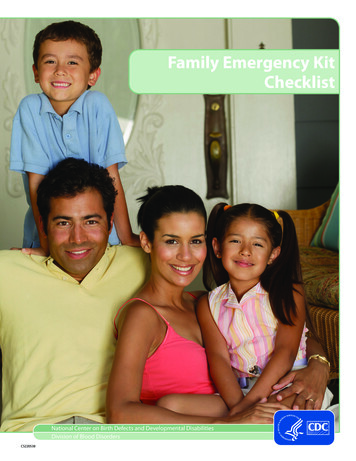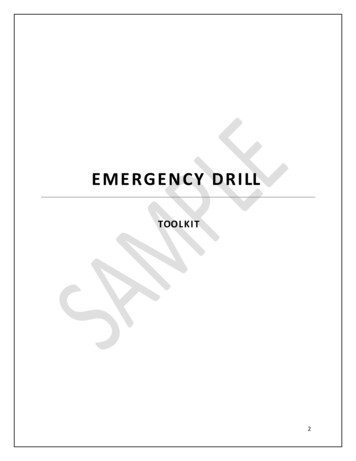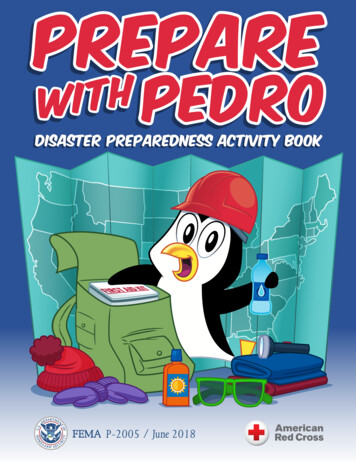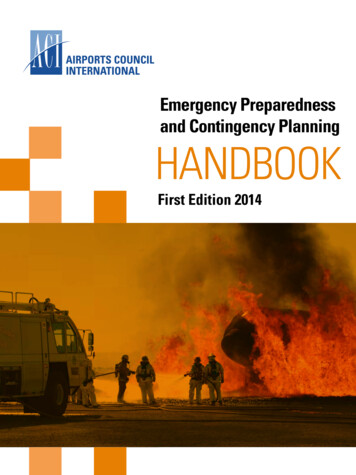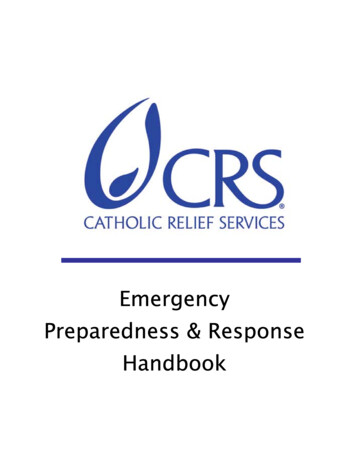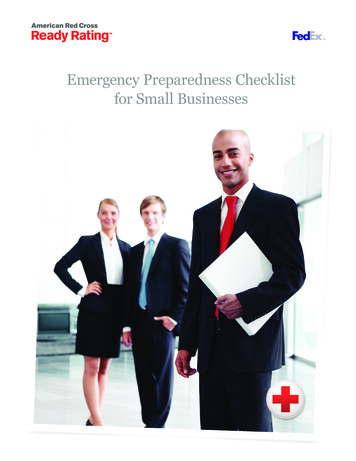
Transcription
Emergency Preparedness Checklistfor Small Businesses
E M E R G E N C YP R E PA R E D N E S SC H E C K L I S TF O RS M A L LB U S I N E S S E SDDeveloping an emergency preparedness plan is one of the most important strategic decisionsyou will make as a small business owner. Consider how a natural, human-caused or publichealth disaster could affect your employees, customers and workplace. Would business operations continue? Preparing your small business doesn’t have to be time consuming or expensive.In fact, experts say one dollar invested in disaster preparedness may save seven dollars inrecovery and Red Cross’ Ready Rating program makes it easy to evaluate your strengths andweaknesses. FedEx and Red Cross care about small businesses. That’s why we’re providingthis checklist. Ask yourself these three questions to help prepare your business to stay inbusiness. Then visit ReadyRating.org/smallbusiness for advice on next steps.Making sure small businesses have the tools to be prepared.Proudly sponsored by FedEx.FedEx service marks used by permission.
E M E R G E N C Y1P R E PA R E D N E S SC H E C K L I S TF O RS M A L LB U S I N E S S E SHow vulnerable would yourbusiness be if a disaster or otheremergency were to occur? Know your region and the types of disasters mostlikely to have an impact on your business. Find out what emergencies have occurred in the past andwhat impact these had on other businesses in your area. Consider your facility’s physical capacity to resist damageand proximity to flood plains, seismic faults, dams, hazardous materials, nuclear power plants and other hazards. Consult with your insurance agent and learn what coverageis available and what precautions to take for disastersthat may impact your business. Remember, many generalpolicies do not cover earthquake and flood damage. Assess the capacity of your employees to prepare forand respond to an emergency. Are 10 - 15 percent of your employees trained in basicfirst-aid and CPR techniques? Do all employees know howto identify individuals who are trained? Are employee roles clearly defined in the event of a disasteror emergency?I dentify external emergency resources that willprovide assistance during or after a disaster or otheremergency. Who will you contact in an emergency andwhat will they be able to provide? Local and state law enforcement. ire department and emergency medical servicesForganizations.Local government officials, emergency management office.Local American Red Cross chapter.Telephone, water, gas and electric companies.Neighboring businesses.Emergency repair and cleaning services.Making sure small businesses have the tools to be prepared.Proudly sponsored by FedEx.FedEx service marks used by permission.
E M E R G E N C YP R E PA R E D N E S SC H E C K L I S T2F O RS M A L LB U S I N E S S E SWhat is your plan to protect thebusiness and its employees before, during and after an emergency? Identify a first-aid team. Approximately 10-15 percent of yourworkforce should be trained in first-aid and CPR so that they canassist in times of disaster or emergency until help arrives. Obtain necessary safety equipment. Budget for and purchase any safety equipment, first-aid kits, Automatic ExternalDefibrillators (AEDs), fire extinguishers, smoke detectors andshelter-in-place supplies that may be needed. Make sureemployees know how to access and use these supplies. Write a plan for responding to emergencies.Your Emergency Response Plan should include: A system for warning employees about emergenciesand communicating with employees and local emergencyofficials during a disaster or emergency. Considerations for the special needs of employees withdisabilities and medical conditions. Evacuation routes from your facility and an establishedlocation where employees should gather.Provisions and a location for employees to shelter-in-place. Develop a Continuity of Operations Plan (COOP). Thisplan will help keep your business operating as it responds andrecovers from the effects of a disaster or emergency situation.Here’s how to start developing a COOP: Establish procedures for COOP activation. Identify essential business functions and staff to carryout these functions. Establish agreements and procedures with suppliers,vendors and other businesses critical to daily operations. Create a plan for conducting business if the facilityis not accessible. Identify records and documents that must be readilyaccessible to perform essential functions and set upelectronic backup systems so they can be safely storedand retrieved quickly.Making sure small businesses have the tools to be prepared.Proudly sponsored by FedEx.FedEx service marks used by permission.
E M E R G E N C Y3P R E PA R E D N E S SC H E C K L I S TF O RS M A L LB U S I N E S S E SWhat can we do to integrateemergency preparedness intoour normal business operations? Educate employees. Consider partnering with community organizations to help create comprehensivepreparedness training. All employees should know: heir role during a disaster and the roles and responsibilitiesTof key personnel at your facility. Warning and communication procedures.Evacuation and shelter-in-place procedures. Practice your plan. Practice makes perfect.Conduct regular emergency drills. Use the drills to assess the readiness of your employeesand your facility.I nvolve both personnel and community responders in theevaluation process and use lessons learned to improveprocedures and training as needed. Encourage personal preparedness among employees.Your employees will be better able to help your businessrespond and recover from an emergency if they know howto prepare their homes and families. Offer preparednesstraining and encourage your employees and their families to: et a kit, make a plan, be informed.GA free online education module is available to helpthem at www.redcross.org/BeRedCrossReady. Encourage employees to identify alternative routesfor going to and from your facility. Remind employees to always keep their emergencycontact information current. Help your community get prepared. Work with local community groups and government officials to ensure that yourcommunity is prepared for disasters and other emergencies. Host blood drives. ork with your local Red Cross chapter to train preparednessWeducation volunteers to conduct preparedness presentations. Contribute supplies and/or services to emergency efforts. Adopt a local school or organization and support theiremergency preparedness programs.Making sure small businesses have the tools to be prepared.Proudly sponsored by FedEx.FedEx service marks used by permission.
community is prepared for disasters and other emergencies. Host blood drives. Work with your local Red Cross chapter to train preparedness education volunteers to conduct preparedness presentations. Contribute supplies and/or services to emergency efforts. Adopt a local school or organiza

